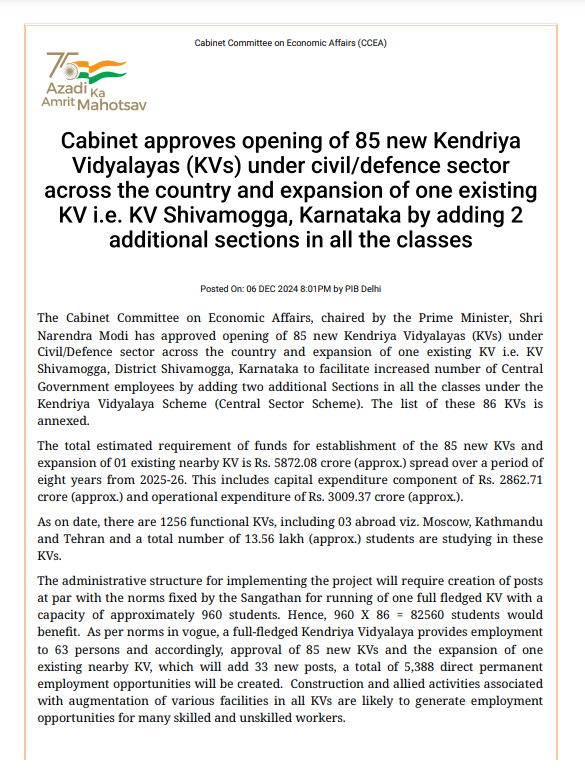
Table of Contents
The Cabinet Announces the opening of 85 new KVs Throughout India
Introduction
- Overview of Kendriya Vidyalayas (KVs)
- Significance of this development
- Role of the Cabinet in educational initiatives
Expansion of Kendriya Vidyalayas in India
Landmark Decision for Education
- Addressing the need for quality education
- Bridging the gap in underserved areas
How Kendriya Vidyalayas Have Evolved Over Time
- History and growth of KVs
- Contributions to India’s educational framework
The Details of the Expansion Plan
Number and Locations of the New KVs
- Regional distribution of the 85 new KVs
- Focus on rural and remote areas
Selection Criteria for New Locations
- Population density and demand for education
- Proximity to existing KVs
Infrastructure and Facilities
- Standards for construction and design
- Key facilities in new schools
Benefits of the Expansion
Enhanced Access to Quality Education
- Addressing the educational divide
- Beneficiaries of the new KVs
Employment Opportunities
- Recruitment of teachers and staff
- Boost to local economies
Promoting Inclusivity in Education
- Admission policies for underserved groups
- Focus on gender equality
Challenges in Implementing the Expansion
Funding and Resource Allocation
- Budgetary considerations
- Ensuring timely fund disbursement
Maintaining Quality Standards
- Teacher training and recruitment
- Adapting to regional educational needs
Overcoming Geographic and Logistical Hurdles
- Accessibility challenges in remote areas
- Ensuring robust infrastructure development
Government’s Vision for Education
Aligning with NEP 2020
- How the expansion supports NEP goals
- Emphasis on holistic learning
Future Plans for Education
- Potential for more expansions
- Long-term goals for Indian education
Conclusion
- Recap of the importance of this initiative
- The promise of a brighter educational future
FAQs
- What is the significance of opening 85 new KVs?
- How are the locations for the new KVs decided?
- What benefits will this initiative bring?
- How does this align with the NEP 2020?
- When will these new KVs start functioning?
Article
Introduction
Education has always been a cornerstone of development in India, and Kendriya Vidyalayas (KVs) stand as a testament to the government’s commitment to quality education. In a historic move, the Cabinet has approved the opening of 85 new Kendriya Vidyalayas across the country. This bold step promises to provide equitable educational opportunities and bring world-class facilities to students in underserved regions.
Expansion of Kendriya Vidyalayas in India
A Landmark Decision for Education
The approval of 85 new KVs is a significant stride toward ensuring quality education for all. By targeting regions that lack proper educational infrastructure, the government aims to bridge the divide between urban and rural schooling systems.
How Kendriya Vidyalayas Have Evolved Over Time
Established in 1963, KVs were envisioned as schools catering to children of transferable Central Government employees. Over the years, they have expanded their reach, offering top-notch education to students across diverse regions, setting a benchmark for others to follow.
The Details of the Expansion Plan
Number and Locations of the New KVs
The newly approved KVs will be strategically distributed across states, with a special focus on rural and underserved areas. This ensures that students from every corner of the country have access to quality education.
Selection Criteria for New Locations
Locations were selected based on population density, the demand for schools, and the absence of nearby educational institutions. This data-driven approach ensures maximum impact where it’s needed the most.
Infrastructure and Facilities
The new KVs will adhere to high standards of construction, equipped with modern facilities like digital classrooms, laboratories, libraries, and sports amenities. These features aim to create an enriching learning environment for students.
Benefits of the Expansion
Enhanced Access to Quality Education
By reaching previously neglected areas, the new KVs will ensure that no child is left behind. Students in remote locations will now have the opportunity to learn in a standardized and supportive environment.
Employment Opportunities
The establishment of new schools brings job opportunities, including teaching positions and administrative roles. This initiative is also expected to stimulate local economies through increased demand for goods and services.
Promoting Inclusivity in Education
KVs are known for their inclusive admission policies, which prioritize children from diverse socioeconomic backgrounds. This expansion will further the goal of inclusive education and equal opportunities for all.
Challenges in Implementing the Expansion
Funding and Resource Allocation
Ensuring adequate funding for infrastructure and operational needs will be crucial. The government’s commitment to timely resource allocation will play a pivotal role in the success of this initiative.
Maintaining Quality Standards
Recruiting qualified teachers and providing them with proper training is essential to maintain the educational excellence KVs are known for.
Overcoming Geographic and Logistical Hurdles
Building schools in remote areas poses challenges related to accessibility and infrastructure. The government must navigate these hurdles to ensure the timely completion of projects.

Government’s Vision for Education
Aligning with NEP 2020
The expansion aligns perfectly with the National Education Policy 2020, which emphasizes equitable and inclusive education. It reflects the government’s dedication to fostering holistic development among students.
Future Plans for Education
This initiative could pave the way for more such expansions, helping India achieve its goal of universal education access by the coming decades.
Conclusion
The Cabinet’s decision to open 85 new Kendriya Vidyalayas marks a milestone in India’s educational journey. It promises to create opportunities, reduce disparities, and inspire countless young minds. With proper execution, this initiative could redefine the educational landscape of the nation.
FAQs
- What is the significance of opening 85 new KVs?
This move aims to provide quality education to underserved regions, bridging the gap in accessibility and standards. - How are the locations for the new KVs decided?
Locations are selected based on factors like population density, educational demand, and proximity to existing KVs. - What benefits will this initiative bring?
Enhanced access to education, employment opportunities, and inclusivity are among the major benefits. - How does this align with the NEP 2020?
The expansion supports NEP 2020 goals by promoting equitable, inclusive, and holistic education. - When will these new KVs start functioning?
While specific dates are yet to be announced, the government is working on a fast-track basis to ensure timely implementation.
